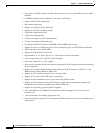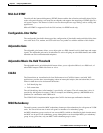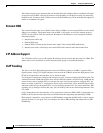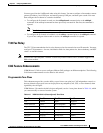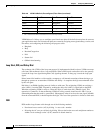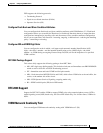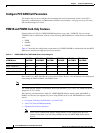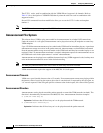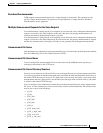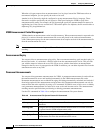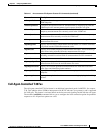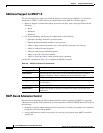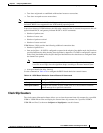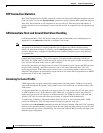
4-62
Cisco VISM Installation and Configuration Guide
Release 3.0, Part Number OL-2521-01 Rev. D0, June 2004
Chapter 4 Configuring VISM Features
Configuring Additional VISM Features
The G.723.1 codec, used in combination with the VISM-PR card, supports 144 channels. Refer to
Table 4-3 for a description of VISM-PR DS0 density when the cards are used in combination with
supported codecs.
Several CLI commands have been modified to allow you to use the G.723.1 codec and template
number 4.
Note The G.723.1 codecs are not supported for VISM cards.
Announcement File System
This release allows VISM to play prerecorded local announcements in switched VoIP connections.
Under the control of a call agent, announcements can be played toward any IP endpoint or toward any
VISM endpoint.
Up to 125 different announcements may be cached on the VISM card for immediate playout. A persistent
announcement storage area exists in the packet network. Announcements are downloaded on demand
from the announcement storage area and remain on the VISM card until they have reached expiry or are
replaced. If the 125 announcement maximum is reached, subsequent requests for announcements not on
the VISM card result in the replacement of “cached” announcements.
Announcements can be played over established connections in any VISM supported codec, but they must
exist on the announcement file server in the desired encoding.
Note You must play announcements in the exact codec in which they have been recorded.
VISM announcements require the support of the MGCP 0.1/1.0 call agent.
Announcement Timeouts
VISM uses a provisionable timeout value of 5 seconds. If an announcement cannot start playing within
the timeout value of receiving the request, the action is canceled and, if requested by the call agent, an
“of” event is reported. If the call agent specifies a timeout value in the request, this value will be ignored.
Announcement Direction
Announcements can be played toward the packet network or toward the TDM network (not both). The
direction is determined by the notation of the MGCP S: line. Announcement direction examples:
S: a/ann(all-lines-busy.au)
Explanation Indicates that all-lines-busy.au is to be played toward the TDM network.
S: a/ann@connid(all-lines-busy.au)
Explanation Indicates that all-lines-busy.au is to be played toward the packet network.



